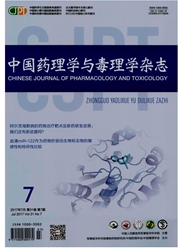

 中文摘要:
中文摘要:
目的:研究慢性应激大鼠体内皮质酮(CORT)变化的动态规律和组织差异,观察姜黄素的干预特点。方法:束缚法建立大鼠慢性应激模型,姜黄素灌胃给药,研究体质量变化、旷场实验、血浆和组织中CORT水平。分别于束缚前、束缚后30、90、120、240和360min连续取血。采用高效液相色谱法检测大鼠血浆与各组织中皮质酮水平。结果:慢性应激大鼠体质量增加缓慢,旷场实验中穿格数和直立次数减少,潜伏期延长,姜黄素不加快体质量增加,但可改善部分行为学指标。应激组大鼠第1天于束缚后30、90和120minCORT水平持续升高,第7、第14和第21天仅在30min时出现CORT水平升高,第1~第14天姜黄素不影响30min的CORT高峰,但可加速CORT下降,且使基础状态组织内CORT浓度降低。结论:姜黄素不损害下丘脑-垂体.肾上腺轴的急性反应能力,但可阻止慢性应激时CORT的持续升高,且使脑、肝等组织局部CORT含量下降,此可能是其抗应激作用的基础。
 英文摘要:
英文摘要:
Objective: To study the dynamic changes of blood corticosterone (CORT) and tissue level in the chronic-stressed rat. and observe the interventional cbaracteristics of curcumin on them. Methods: Chronic stress was induced by immobilizing the rats for 6 h daily for 21 days. Body weight and open field test were evaluated to assess stress-lnduced functional changes. Corticosterone in blood and tissue was assayed with high performance liquid chromatography (HPLC). The blood were collected before restrained and when restrained for 30, 90, 120, 240 and 360 min in day 1, 7, 14 and 21. Rats were executed and the brain, llver, adrenal, kidney and blood were collected in day 22 when rats were not restrained. Results: Chronic stress resulted in weight loss and behavior deficits in rats. Curcumin could attenuate behavior deficits induced by chronic stress. In day 1 the blood level of CORT was increased when restrained for 30, 90 and 120 min, but in day 7, day 14 and day 21, the blood level of CORT was increased only at 30 min restrained. Curcumin could not eliminate the CORT peak at 30 min restrained, but decreased the blood CORT level at the subsequent time. Curcumin also decreased the CORT level in brain and liver in day 22 when the rats were no longer restrained. Conclusion: These results suggest that curcumin prevents against the persis-tent rise of CORT induced by chronic stress but don' t reduce the responsiveness of the hypothalamo-pituitary-adrenal axis (HPA). The change of CORT level intervened by curcumin in our stress model helps to protect rats against chronic stress.
 同期刊论文项目
同期刊论文项目
 同项目期刊论文
同项目期刊论文
 Effects of methoxychlor and its metabolite 2,2-bis(p-hydroxyphenyl)-1,1,1-trichloroethane on human a
Effects of methoxychlor and its metabolite 2,2-bis(p-hydroxyphenyl)-1,1,1-trichloroethane on human a 期刊信息
期刊信息
